|
Cheryl Brophy-Chan’s personal account
I left the temple only moments ago. This is an instantaneous and genuine account of what I’ve witnessed today. I am feeling extremely privileged, I remain in a state of awe about Taoism, and to some extent a little disbelief too, but I’m certainly not judgemental at what I’ve experienced.
Surprisingly it took only 25 minutes drive from Bangsar to reach the temple gates for the scheduled 11am meeting point. Along the winding, narrow and bustling approach, my mind contemplated what I was about to enter.
Stepping out of the car, the huge, colourful gates were before me. Instantly I felt incongruous, so I glanced around for familiar faces. Within seconds I heard a friendly voice, and my name was efficiently ticked off the list of 24 attendees. Together, we crossed the dusty, busy road and weaved our way into the very back of a compact local restaurant. The walls were white tiled, and a modest ceiling fan circled and cooled us from above. The natural light streamed through wooden blinds while we waited briefly for everyone to arrive and settle. Coincidentally, not one person had cancelled out for this tour, like me, everyone was intrigued and committed. |
|||
 |
 |
 |
|
|
Cheryl Hoffman, our tour guide then stood. She was brimming with smiles, enthusiasm and a vast knowledge about the nine day event. During her 13 annual visits to this festival, it was evident that Cheryl has gained an immense insight into the temple’s activities, and more importantly a genuine trust of the local participants.
Cheryl started by explaining the importance of this particular temple, and that is considered the ‘mother’ temple for this festival in Malaysia. She highlighted that the underlying rituals performed here are Taoist in nature, and honour of the Nine Emperor Temple Gods, and that this always occurs during the 9th Lunar Month of the Chinese calendar. She explained that the believers are praying to a Taoist energy that helps to resolve their problems, or perhaps cures them. The act of worshipping the Nine Emperor Gods, supposedly originated from Fujian China, then it spread to Malaysia, southern Thailand and Singapore.
Cheryl acknowledged that there are different myths about the event. Some believe the event honours the lives of a group of brothers who helped cure people during a plague. Others believe they were opera performers, fishermen or even sea pirates who were beheaded. Their heads were placed in urns and floated out in the China Sea. Then upon discovery, it is believed that they ascended into heaven and took up residency in the Big Dipper. Whichever story is believed, the constant theme is that these are the sons of the ‘Dou Mu’. She is the highest female deity in the faith, and the Goddess of the North Star. Effectively, you attend the event to mourn her sons. Hence devotees dress respectively in white and eat strictly vegetarian food. They refrain from alcohol, smoking and even sex for nine days, all as a sacrificial symbol of their respectfulness.
Cheryl enlightened us further by explaining that up to 300 devotees not only attend the event, but actually stay within the confines of the temple during the nine days. They enthusiastically pay about RM300 to sleep on hard, raised platforms, in single sexed dormitories with communal showers and facilities. Among the female devotees are generations of women who gather to worship, eat three meals a day and modestly share time together. Through their devotion and worship, they hope to bring the universe into a balanced state. They believe there is good and bad in the world and that we must strive for harmony. How they achieve this starts on the eve of the festival. A designated Spirit Medium among the worshipers goes out from the temple and collects water from a nearby river source. Within this water, it is believed that the spirit of the nine emperors spontaneously arrives at the festival.
Both the elements of water and fire feature during the rituals at the temple and are significant. For example, on the eighth to ninth day of the festival, certain male devotees perform acts of cleansing by walking across a bridge of hot coals of fire. Providing they are pure of heart, they will not feel any pain. Equally, simple acts of mourning are meaningful too and are conducted in a specific manner. Such as the frequency a devotee prays.They pray three times a day in designated areas of the temple, and in a specific order. With clasped hands they offer their prayers with little movements in groups of threes.
Interestingly, within the temple, there is an altar with an urn and a special rock which represents the power that they worship. There is also a mast like pole with burning oil lamps to signal to the ancestors. Next to that there is a giant straw stack on which symbolic artefacts such as shoes and white clothing are burnt for the Emperors. Also, an unknown male would be seated behind a special yellow curtain. Many of these curious aspects are not apparent at first, and are held in secrecy. It has taken years for Cheryl to be entrusted with such facts and her animated introduction had me captivated. Heightened with all this knowledge, it was time for us to enter the temple on the third day of festivities. |
|||
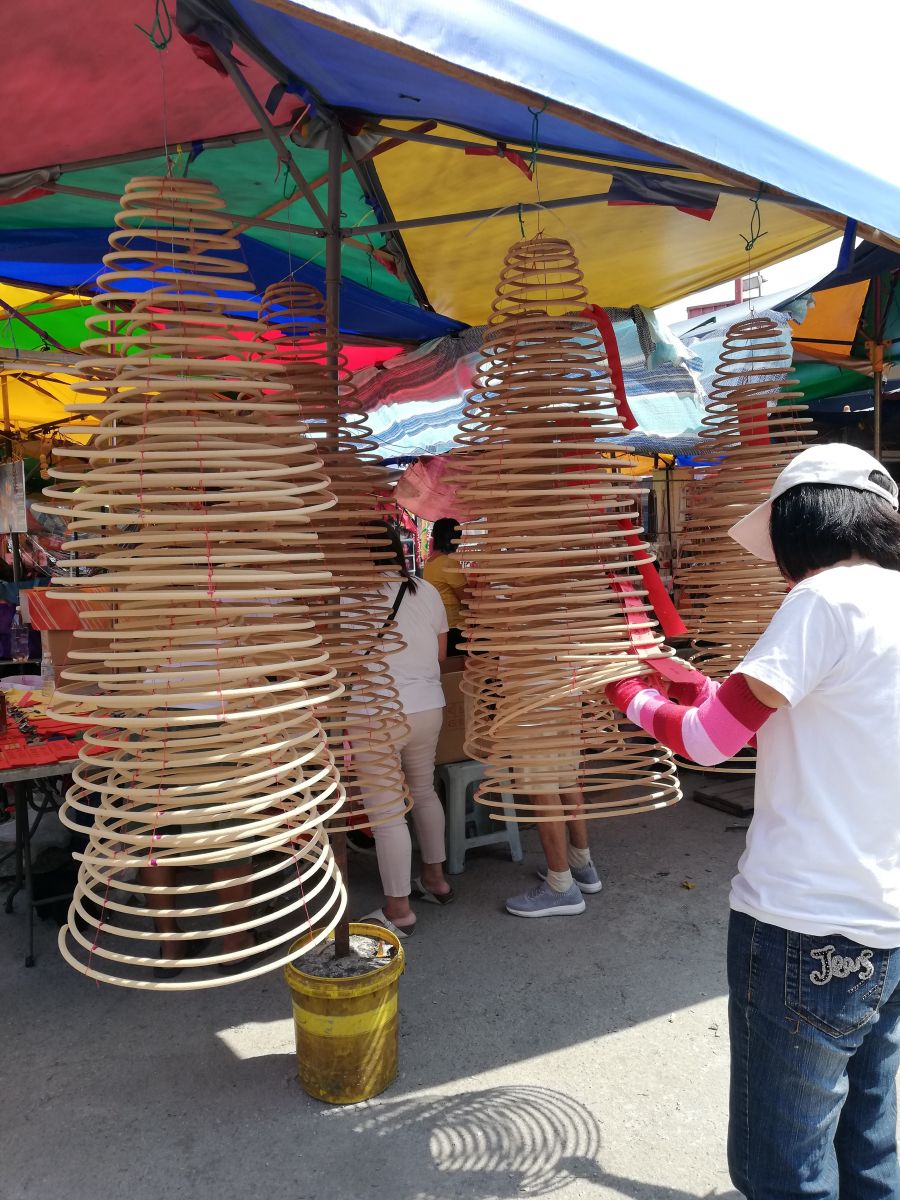 |
 |
 |
|
|
As we passed through the gates, immediately tables flanked our pathway. Vendors selling brightly coloured sacrificial turtles, and bundles of joss sticks politely vied for our attention. Thanks to Cheryl’s familiar face, we felt welcomed and free to move around the various parts of the temple. The place was alive, and in parts colourfully festooned with tassels and silk banners. At times the air was filled with atmospheric smoke from the altar, and the mournful mood was tense and sombre. |
|||
 |
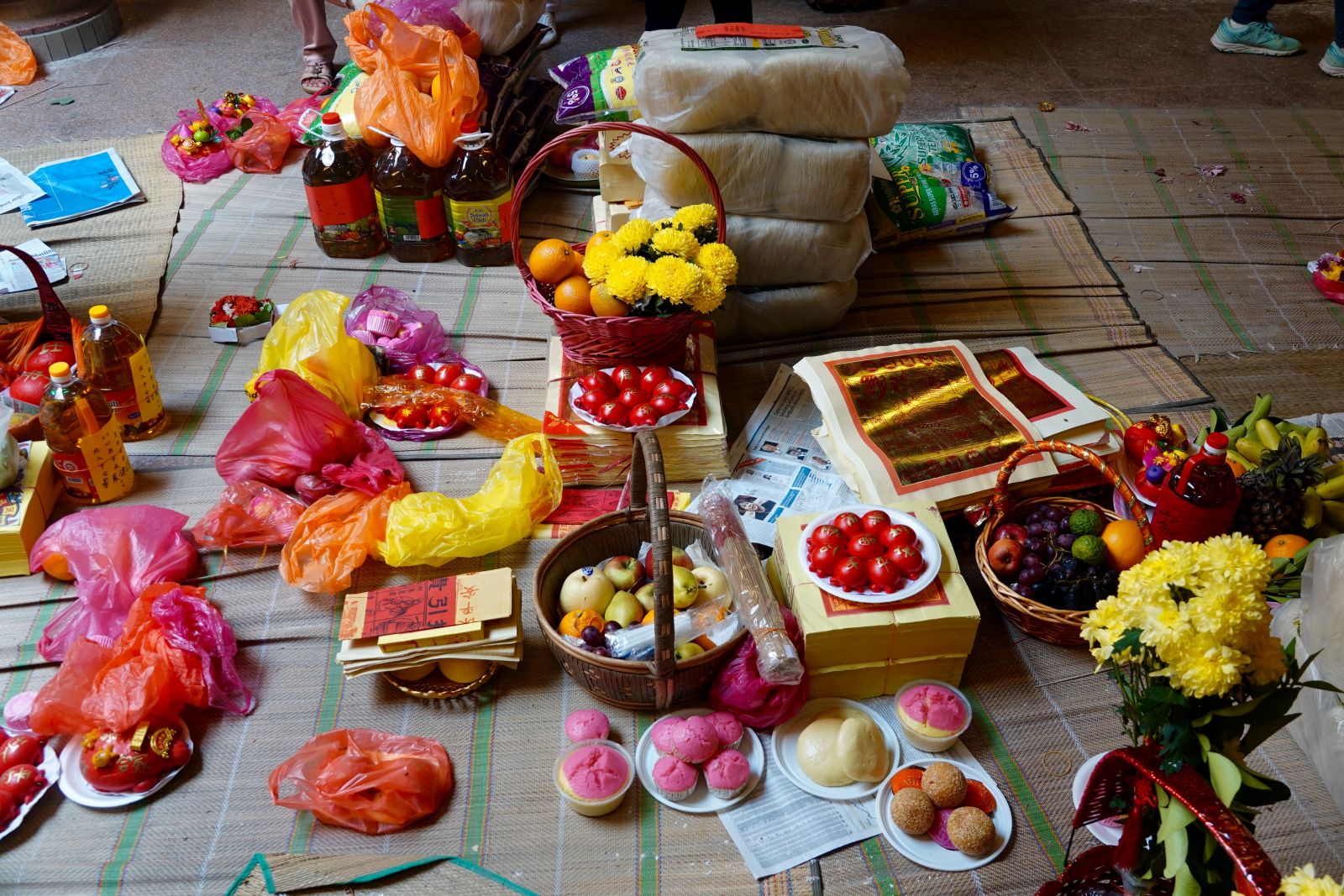 |
 |
|
|
Next, we progressed through the temple and entered what appeared to be the inner sanctum. Fearlessly, Cheryl rang a large bell suspended above us at the wide arched entrance. Inquisitively we filed in behind her. On our right, in return for our entry, or our donation, we were offered a talisman. It consisted of a bundle of paper with a yellow ribbon that was later to be tied on our wrist to denote our visit. Before us on the floor, lay stacks of sacrificial money, plates of red painted turtle offerings, symbolising long life, and baskets of fruit and flowers. People were here to pray for good luck, good health, long life and protection. Some were kneeling and shaking a pot of numbered sticks. Their first stick to fall from the pot was then taken to a side counter. Here a corresponding poem could be claimed as an answer to prayers and questions. One of the ladies in our group knelt and entered into the spirit of the proceedings. The number 47 stick fell from her pot. She unravelled her poem, but none of us were able to read the Chinese inscription let alone interpret it. As we left that area, we noticed a couple seeking advice from what appeared to be a fortune teller who was pointing out facts in his thick, pale yellow directory. |
|||
 |
 |
 |
|
|
Next we passed a tower, with a woman sitting behind a counter. From her you could borrow a small sum of money on the basis that next year you would return with double the amount. Here, you could also donate money that would support a local Chinese school. Or from another vendor, pay to have your name painted on a handmade lantern that would be hung in the temple.
At this point, we ventured into our first female dormitory. Immediately, the ladies turned and smiled. Surprisingly they were open to posing and being photographed in their lightweight white tops and three-quartered length trousers. The room was clean, basic and orderly. Like in a train, possessions were sparsely hung on small shelves, above their staged sleeping areas. Many of the ladies greeted Cheryl fondly. They expressed such delight to see her once again, and offered the same warmth to us. Then as we progressed through into the next dormitory, we glimpsed an alley of thriving potted plants with shuttered openings and a shaft of light from above. Cheryl then lifted a white sheet before her. Inside we encountered yet more groups of white clad ladies playing Chinese traditional games. The mood was positive, happy, but still modest and quietly respectful. Again the ladies were unfazed by our cameras, and amusingly some mirrored our clicks and photographed us.
|
|||
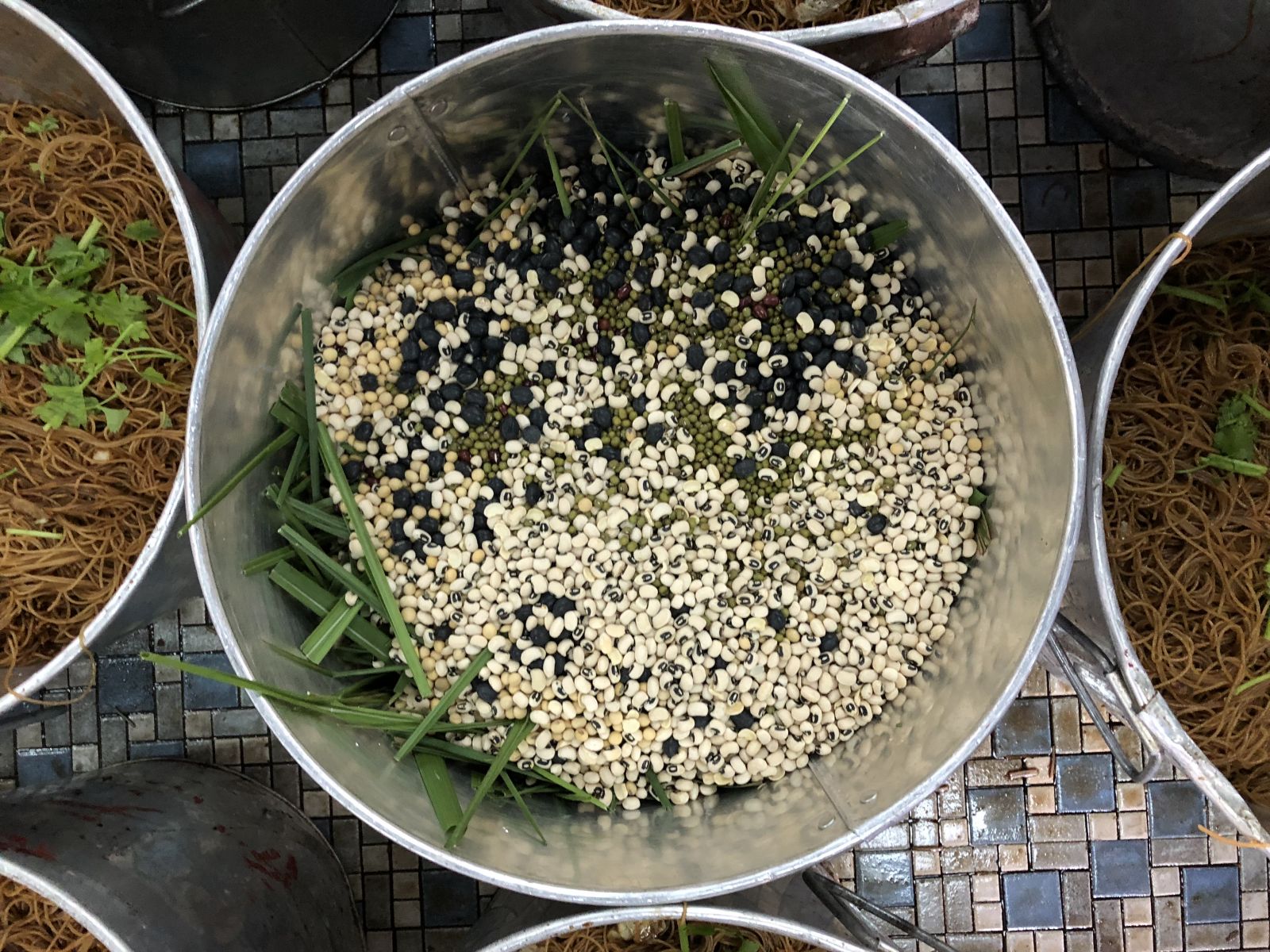 |
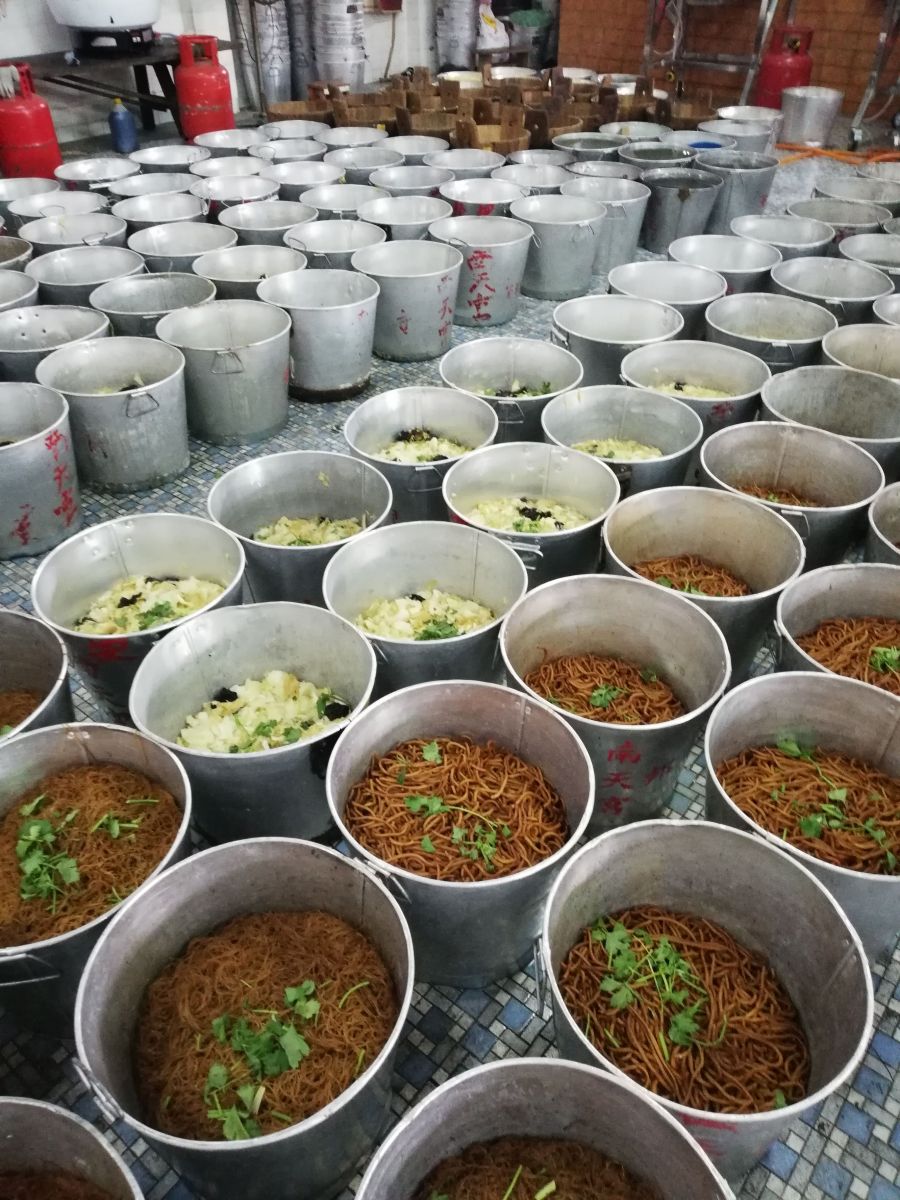 |
 |
|
|
We continued through myriads of rooms and corridors, passing more vendors until we reached the vast kitchen that nourished the devotees. Instantly, we were offered a free bottle of water and encouraged to enter. Arranged on mass on the floor, were steel buckets of brown noodles, each adorned with sprigs of chopped, fresh herbs. To the side were a series of truly massive, fixed stir fry pans, each heated from beneath with open log fires. Beside them were large cooking utensils the size of garden tools. Along the other side sat a line of committee officials around a table, who appeared to be observing the whole operation. |
|||
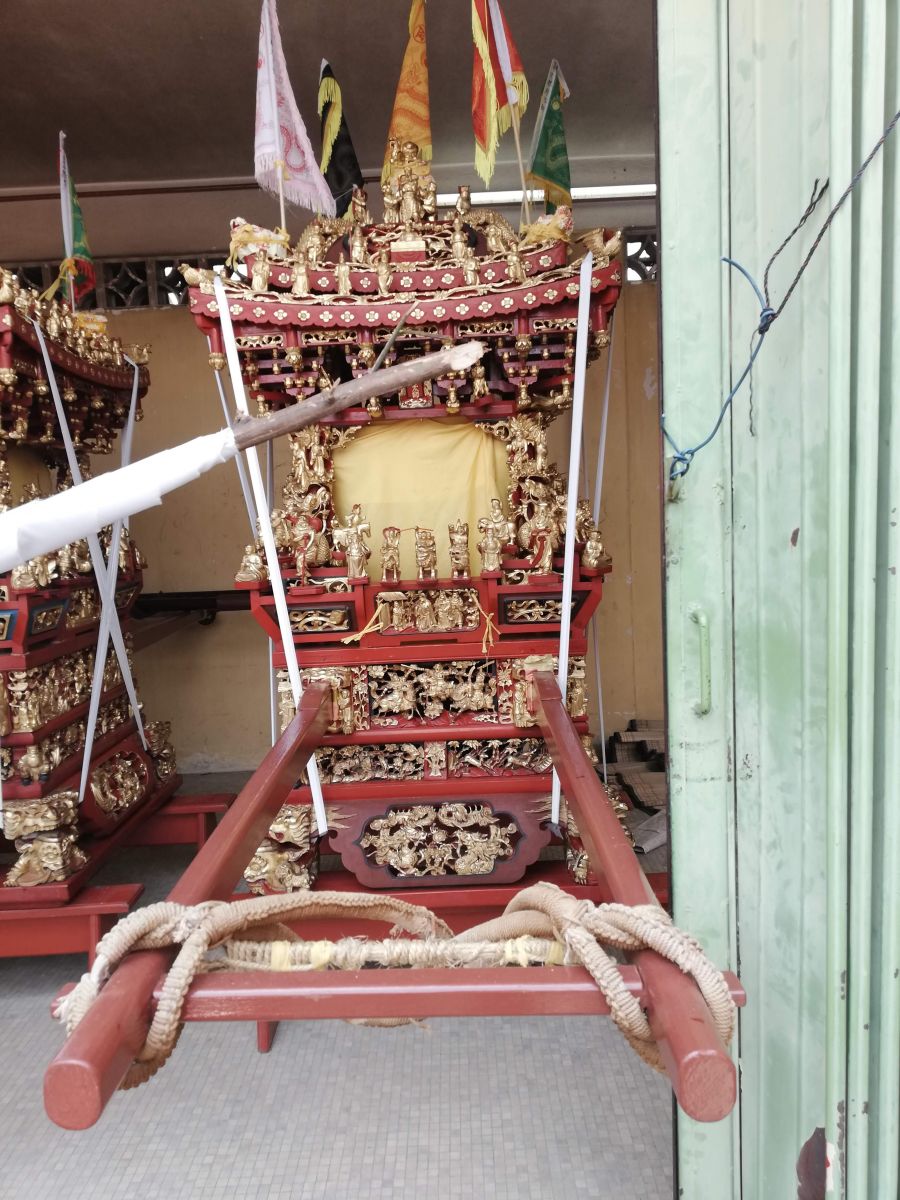 |
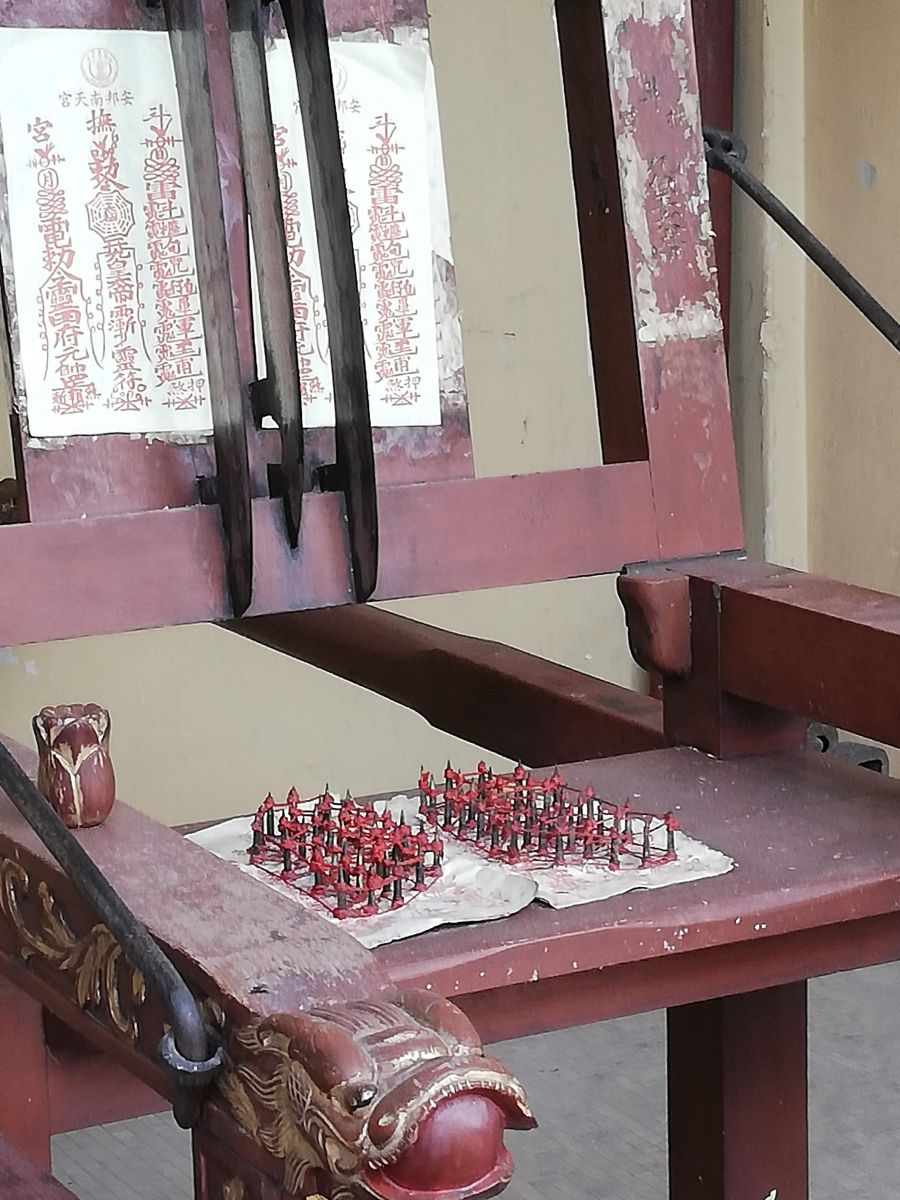 |
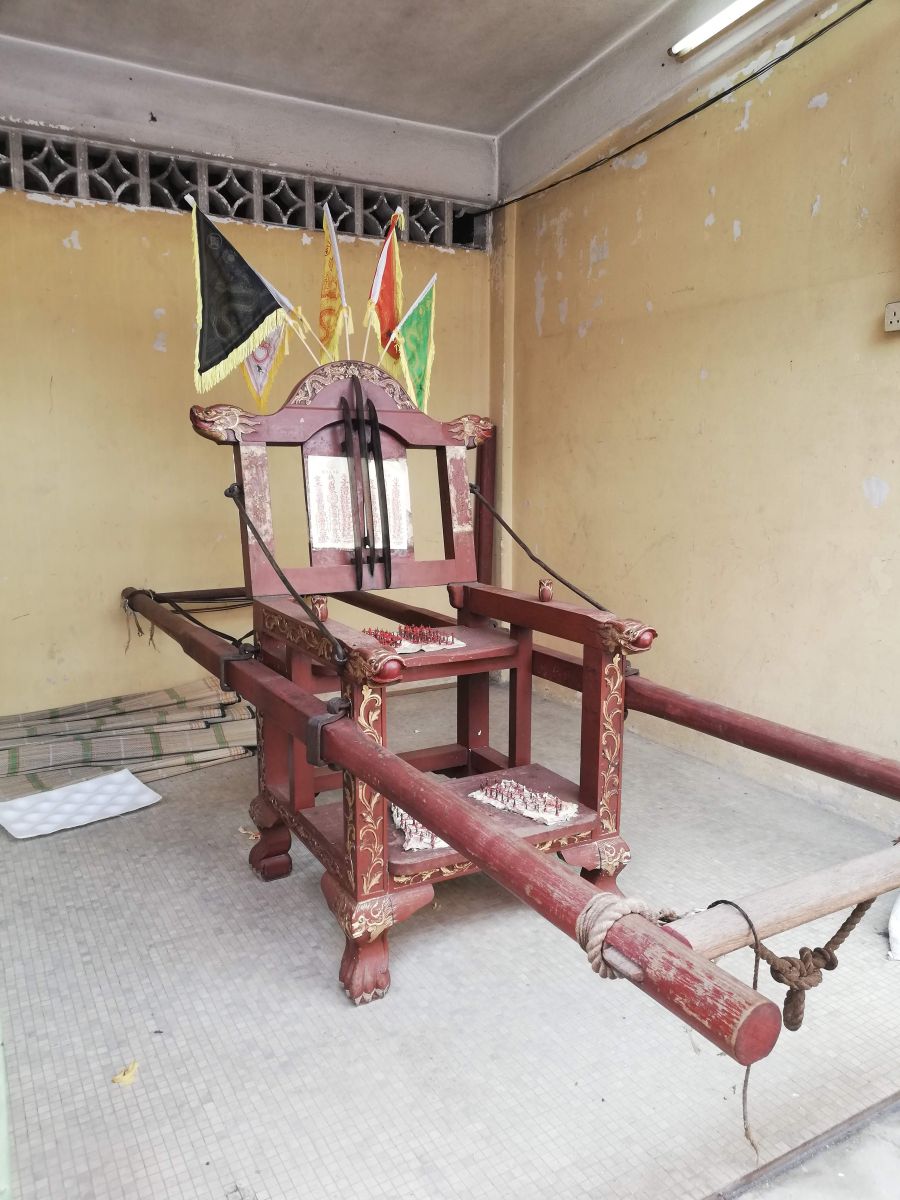 |
|
|
We left the kitchen passing numerous ceremonial artefacts along the way, including what looked like a sedan chair. On second glance, it seemed quite ominous and torturous. It had pads of nails on both the seat and foot parts, and even three blades protruding from the upright back of the chair where the sitter would naturally lean. Also, I noticed that attached to the headrest of the chair were five pennant shaped flags. They were respectively coloured: green, red, yellow, white and black and trimmed with a yellow fringe. I pondered their meaning and later noted similar shades on the clothing of individual performers. |
|||
 |
 |
 |
|
|
At this juncture we were directed to a buffet area for lunch. On offer was a variety of colourful vegetarian food. Each in turn, we served ourselves with an abundance of tasty food and then selected a refreshing drink. The food was modestly priced and quite a feast depending on the braveness of one’s selection. We ate and reflected on what we had encountered. The general consensus was one of admiration for Cheryl’s knowledge, and what an incredible experience to have shared. |
|||
 |
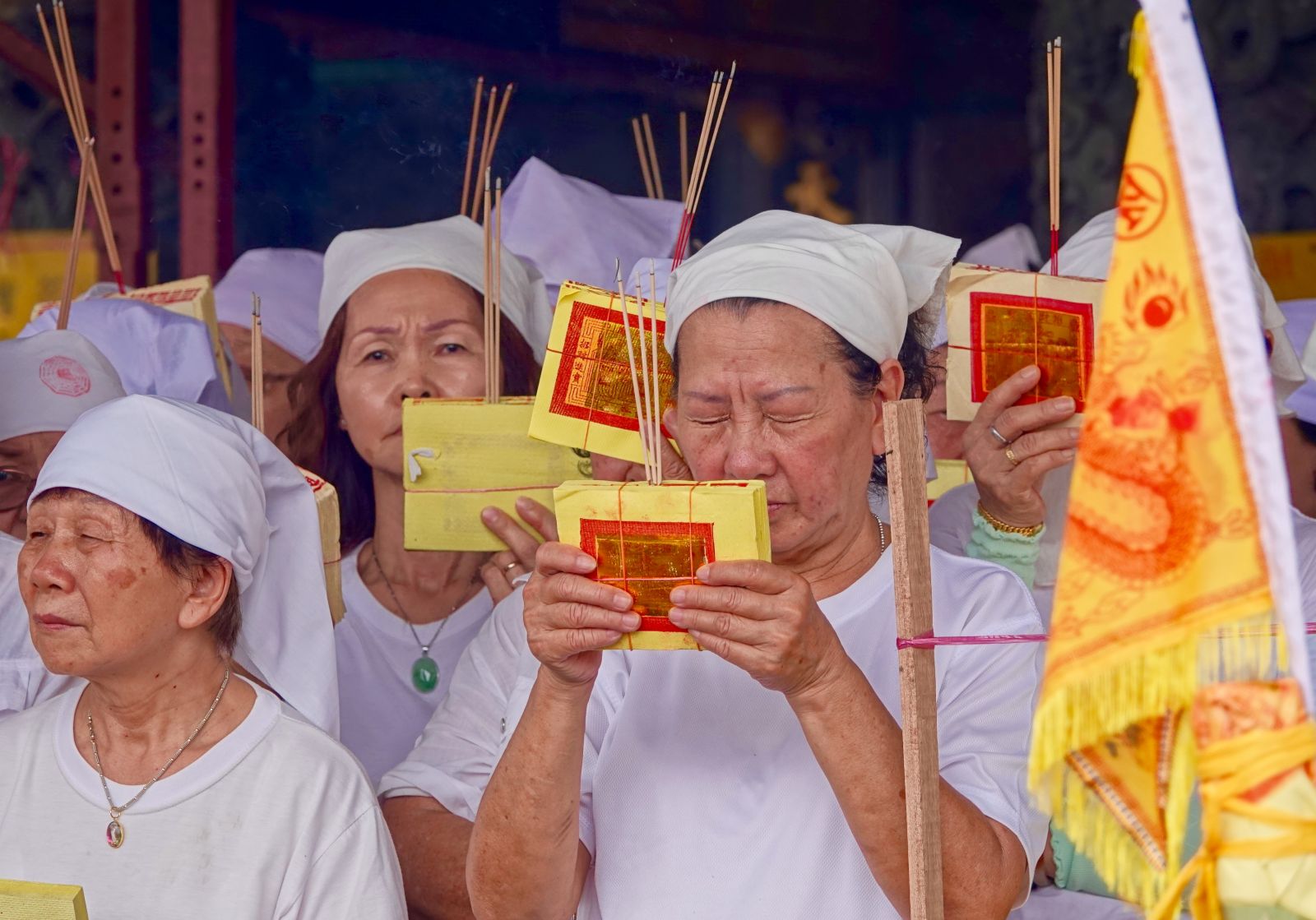 |
||
|
After our lunch, some of our group had to leave, while others stayed and watched the most memorable spectacle of the day. A tad uneasy, we clustered around a tall table, or sat beneath it on sheets of flattened cardboard which had been thoughtfully prepared. Directly opposite, were all the white clad ladies whom we had seen earlier in dormitories. Now composed and lined up before us like a choir. Each one wearing a white headscarf, clutching three joss sticks and a bundle of perhaps sacrificial money. Positioned in front of them was a large terracotta pot of burning ash containing a single yellow and red flag, and rows upon rows of wooden pails. Each pail contained a single cane of bamboo with what appeared to be a taper at the top. None of our group, except Cheryl, knew what we were about to witness. Actually, it’s somewhat difficult to express in words what passed before us and how it made me personally feel.
|
|||
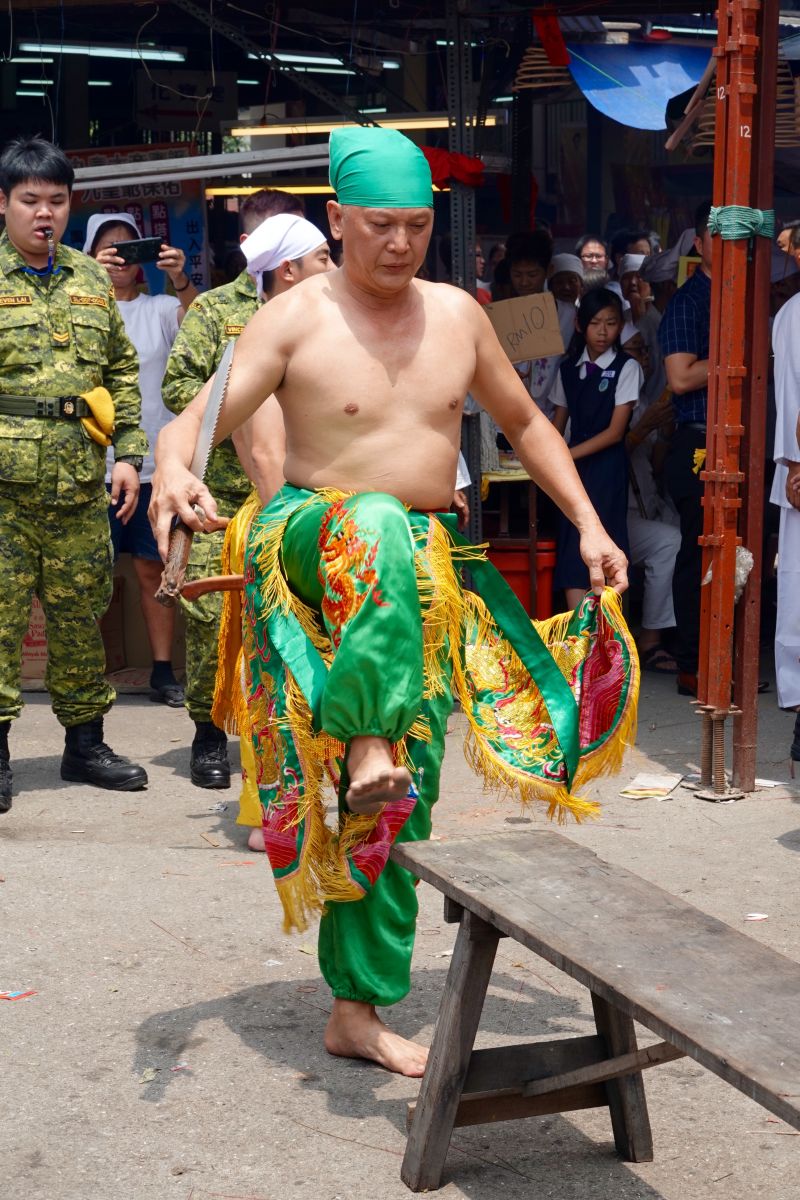 |
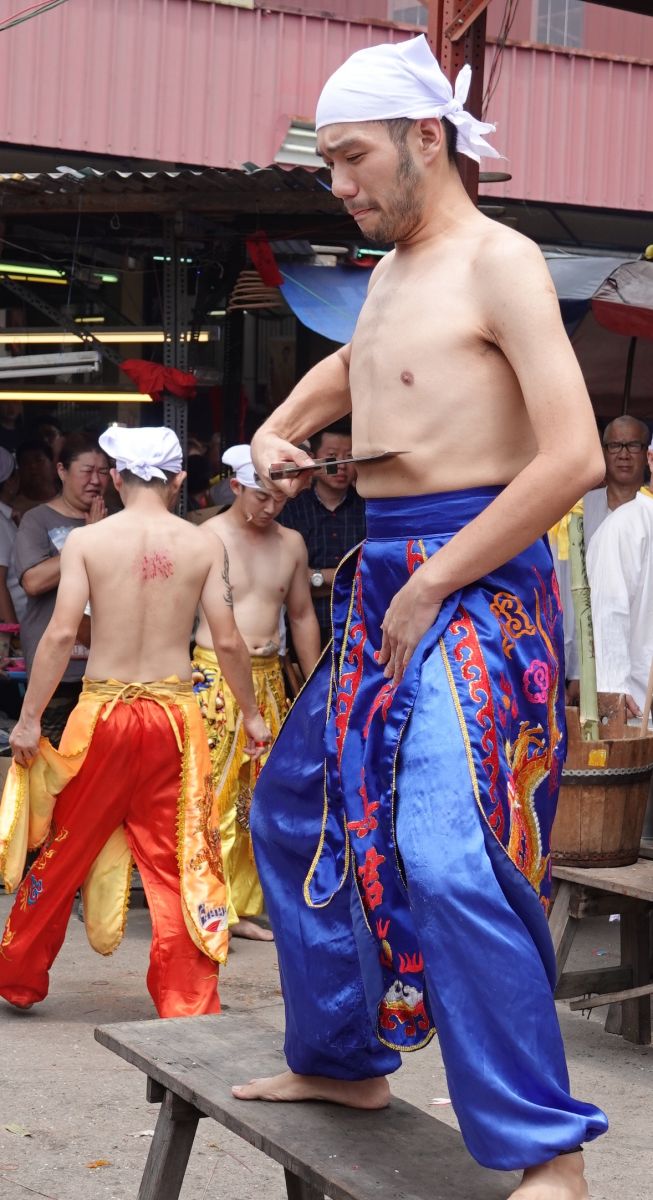 |
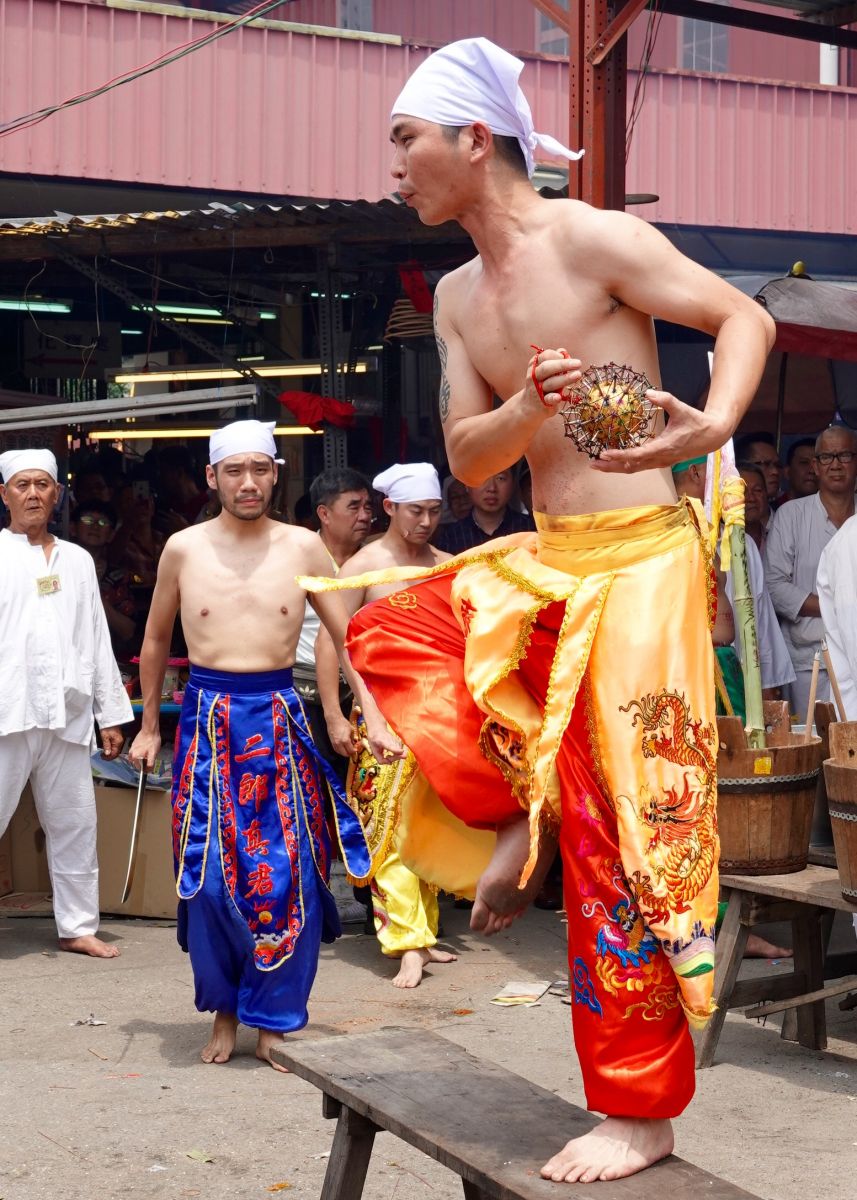 |
|
|
The ceremony commenced, and like a bugle signalling a fox hunt, a reed instrument resounded. Simultaneously, a gong was repeatedly struck, almost similar to the drum beat in a traditional Chinese Lion Dance. I could hear a bell too and even a whistle. The unsettling sounds built the suspense and were continuous throughout the whole ceremony. Then a select group of men began to circle a bench in front of us. Some were were fully clothed in black silk clothing, while others were bare-chested and dressed in colourful, embroidered silk trousers and coordinating headscarves. Suddenly their vivid colours triggered a memory of the flags adorning that sinister sedan chair, so I pondered a possible connection.
Dressed in green, the first barefooted performer climbed and balanced himself on a centrally positioned narrow wooden bench. The weathered, bench was about a metre in length and about twenty centimetres wide. We were instantly transfixed. The stooped performer turned his back to us, raised his sword above his head, and began fiercely thrashing his body front and back with the vertical blade. With each strike and bowing movement, the fringe on the tails of his trousers swayed and dramatised his actions. He then turned to face us and taunted us with yet more acts of self-flagellation. This time he held one of the three embroidered dangling sections of his silk trousers in his left hand, while making rapid and frenzied horizontal strikes to his stomach again. He repeated these horrific actions twice, pausing only seconds between each series of slashes. He uttered no cries or outbursts, looked determined and resolute throughout his complete ritual, despite blood seeping from his self-inflicted wounds. In a choreographed movement, he then twisted his right foot to his right, vertically lowered his sword behind his right shoulder, signally his imminent dismount from the bench.
Within seconds, the next performer mounted the raised bench. This one dazzling in yellow silk trousers and a white headscarf, and brandishing two shiny handheld axes. Then in an almost trance like state, he commenced and maintained a peculiar rhythmic shake of his head with slight movements, left and right. Now with both axes poised, he proceeded to position the first curved blade on the right third of his lower bare stomach. Then with the might of the reversed second axe, he struck the aligned first axe determinedly three times. He appeared to impale himself, whilst constantly looking down at his actions and shaking his head. He repositioned his axes again and repeated the same ritual on the left side of his stomach, and once again on his central torso too. Next he raised the axes higher, and with scarily wide eyes staring above, he made the same three distressing strikes to the base of his neck. Still persistently shaking his head, he turned his back to us and performed the same self-flagellation for the group of white dressed devotees behind him. Then with a quick bend of the knees and a back flick of his feet right and left he dismounted. |
|||
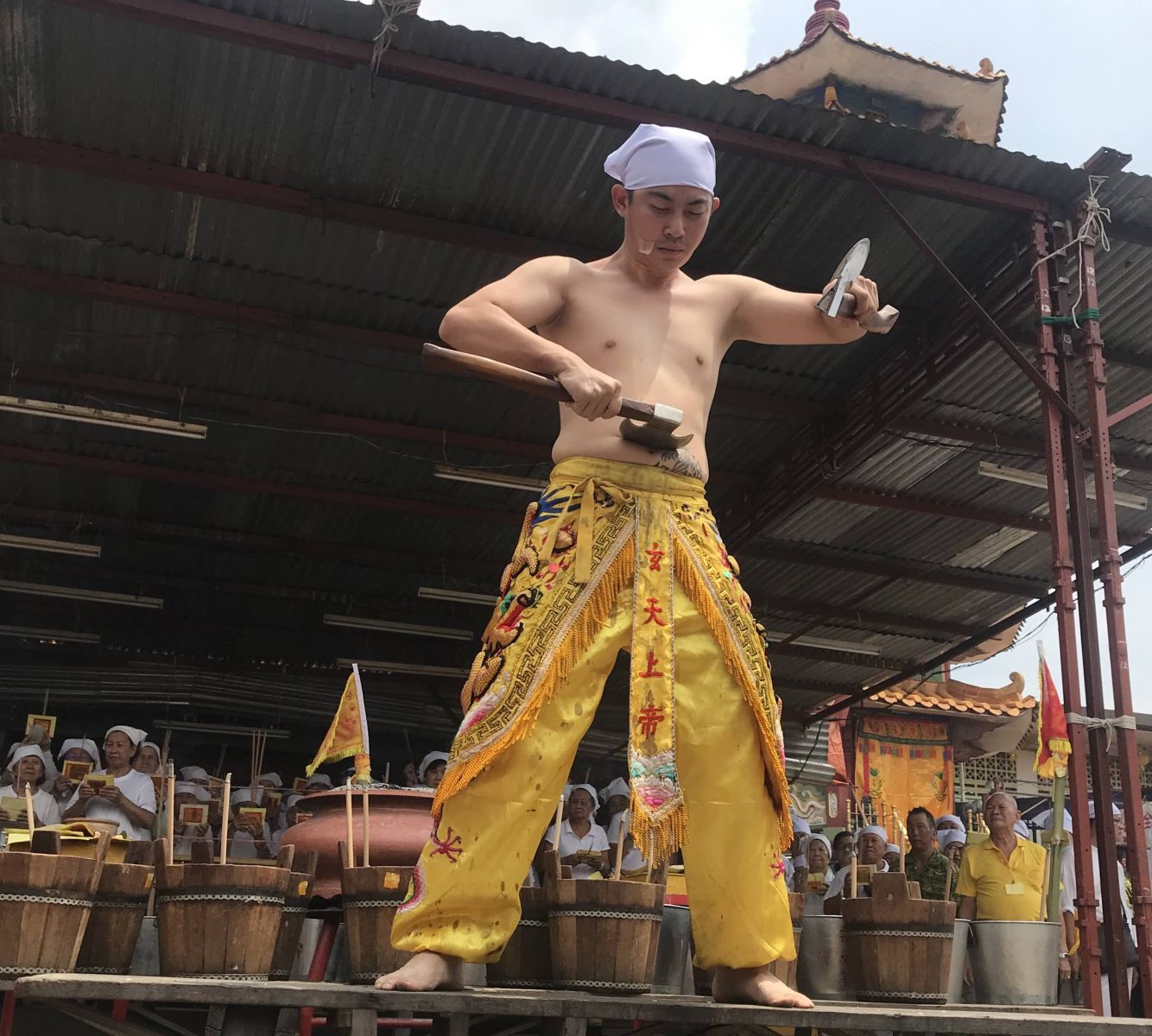 |
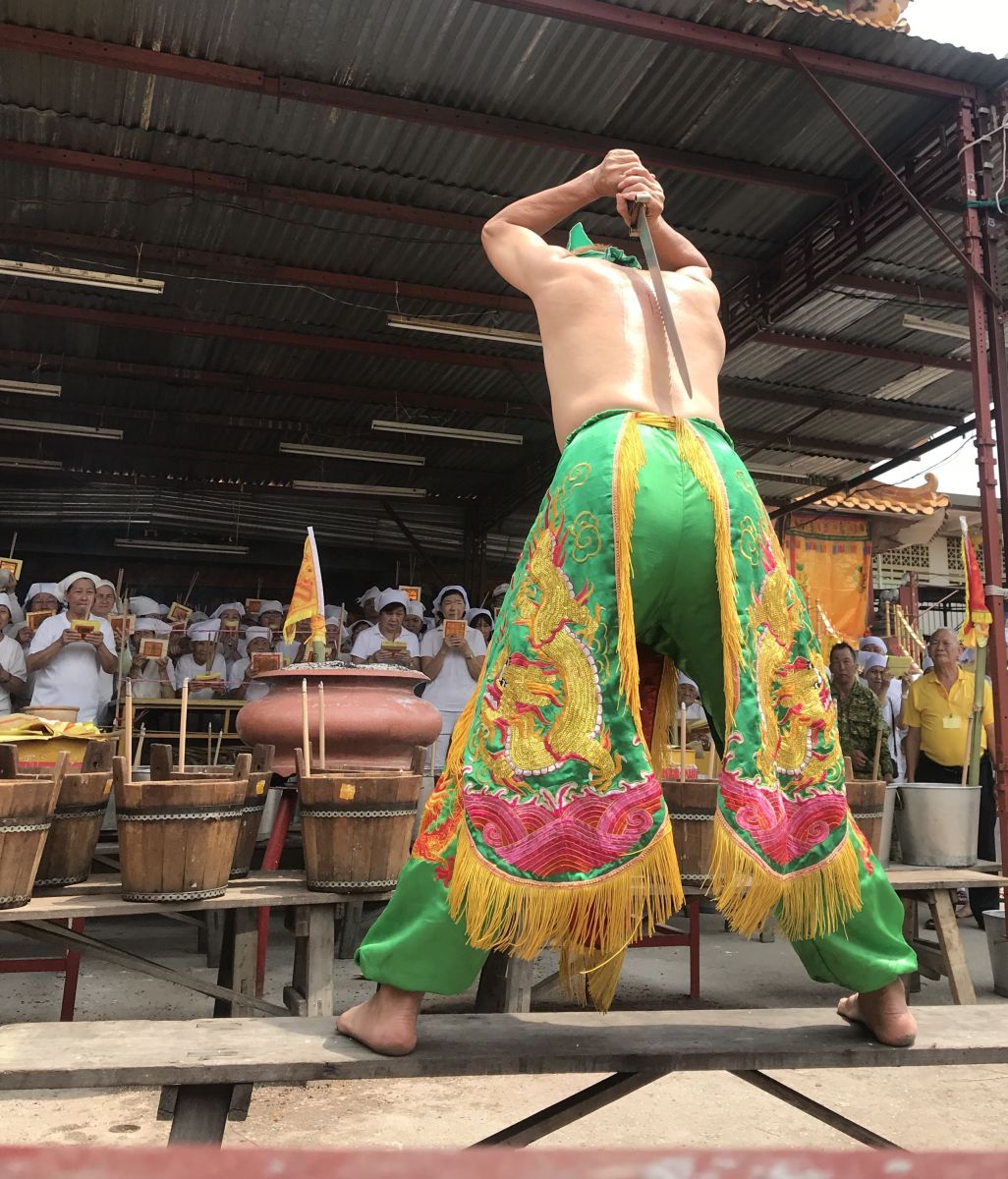 |
 |
|
|
The perpetual music held us on edge while the third performer took centre stage. Dressed in yellow and red elaborated trousers, he looked upwards and raised a yellow ball of nails high above his head. Then dangling this ball of spear-shaped nails from his clenched right fist, he proceeded to flog himself with it. I restrained my gasp, as I watched him swing the ball of metal terror diagonally across his bare body. Up and down, from his back to his front, his torturous moves impaled his body and drew blood. He, like the one before him, bowed, bent his knees, then flicked back his feet and departed.
Immediately yet another performer entered the ring and flog himself with a long curved blade he was followed by an older performer yelling out as his swung his straight blade over himself, speechless, I could see some blood beading between his shoulder blades. Next, I watched him swagger as he then swung and swayed his hips rhythmically to the gong while he slashed his stomach. Finally he stepped down and signalled with his legs, the completion of his act. Briefly he circled before us, and strutted with his fellow performers before finally exiting to a quietening gong.
I felt numbed from the intensity and exhausted from the heat of the day. I thanked Cheryl Hoffmann profusely for such an extraordinary experience, and she kindly directed me to the exit. I left the temple and walked back into my life, but the experience remained with me well into the next day and beyond.
Words by Chery Brophy Chan Photos by Michelle Pease, Yvonne Russell & Aline Burkle |
|||




